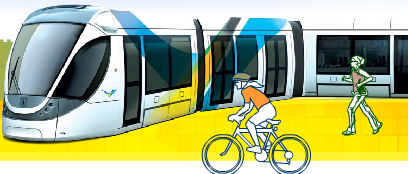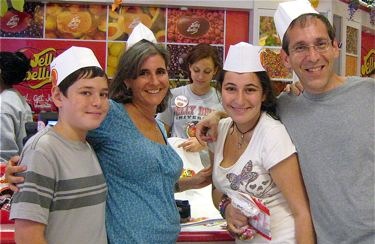 Stepping into one of the sleek and shiny new light rail vehicles set to zip through Jerusalem in the next year and a half, it’s hard to imagine the controversy the system’s roll out has engendered.
Stepping into one of the sleek and shiny new light rail vehicles set to zip through Jerusalem in the next year and a half, it’s hard to imagine the controversy the system’s roll out has engendered.
CityPass, the international corporation that is building and operating the Jerusalem light rail system, recently opened the doors to its hi-tech transit depot and we joined the tour. We learned more than we wanted to know about the facility’s electricity system and the minutiae of how the maintenance staff cleans dusty wheels.
The highlight for us, though, was getting a chance to wander through the train cars themselves. Despite seats still wrapped in plastic, the enormous vehicles – five times the size of a normal bus – were immensely impressive and a stark contrast with the desert landscape around them (the depot is located just west of the northern Jerusalem satellite community of Pisgat Ze’ev).
Each car consists of five articulated sections and can seat 64 (with a total capacity of 250). There are LCD screens to announce stops and magnetic card readers throughout. 24 cars out of a total of 46 have already been delivered so far.
The Jerusalem light rail has a few features not found in other locations, like France and Spain, where CityPass is operating. The vehicles have to contend with Jerusalem’s notorious hilly terrain. And all the windows have been reinforced to be resistant to stones and Molotov cocktails. A controversial security decision has meant that the light rail travels through the Arab neighborhood of Shuafat…but makes no stops.
Nevertheless, visiting the depot and seeing the cars all in one place gives one the feeling of being in a sci-fi flick: could these state-of-the-art contraptions ever roll through the historic but out of fashion center that represents Israel’s capital?
But that’s just the point.
Jerusalem used to have a more vibrant downtown. But in recent years, many of its more upscale shops have relocated to the Malcha Mall and tourists now flock to the Emek Refaim area. Much of the town center has been reduced to a sad medley of hole-in-the-wall shops selling cheap shmatas and rowdy teenagers who haunt the night hours.
That’s why I’m so enthusiastic about the light rail. Upon its completion, Jaffa Road will turn into a pedestrian-only walkway with the new fangled trolleys running down its center.
Freed from the narrow sidewalks and never-ending traffic, the street will experience a resurgence. Already you can see a row of new cafes in the space of a few blocks, flanked by my favorite The Coffee Bean and Tea Leaf (the only branch in Jerusalem). A European-style walker-friendly promenade is just the ticket for revitalizing Jerusalem’s core.
Getting there may not be so easy.
Jaffa Road is in the process of being dug up. Large swaths are currently blocked off entirely. Buses have been diverted to adjacent Nevi’im Street which is much too congested to handle the flow. Construction has been painfully slow, leading mayor-elect Nir Barkat to call for the entire project to be stopped and be replaced by high-speed buses.
I’ve already lived through this once. When I was growing up in the San Francisco Bay Area, the City’s main artery, Market Street, was dug up for nearly a decade during the building of the BART subway. Businesses folded and Market Street was off-limits for private cars and buses alike.
Eventually, construction was completed and the street now boasts a range of trendy shopping and entertainment facilities. The subway brings in visitors from all over the Bay Area, conveniently and quickly. No one discounts BART’s effectiveness today.
The same will undoubtedly be true for Jerusalem.
A project as grand and complex as Jerusalem’s light rail system has never been attempted before in Israel (the high speed train between Jerusalem and Tel Aviv may eventually top it, if it doesn’t get derailed for the umpteenth time). After a peek at the vehicles that will, hopefully no later than 2010, rattle through town, I remain an enthusiastic supporter.

